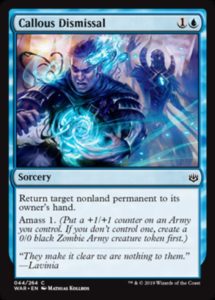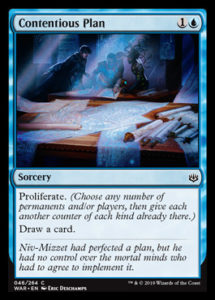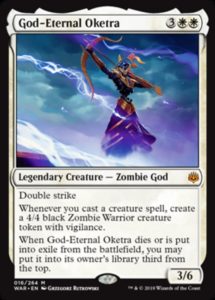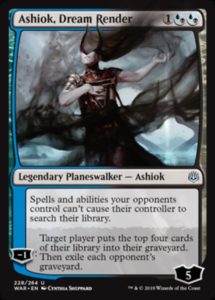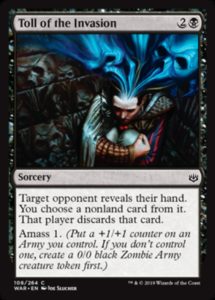War of the Spark is finally out, and it’s a pretty spicy format filled with powerful commons, various synergies, and tons of Planeswalkers! Today, we’ll look at some of the most important cards in the format. This will be give us perspective into the major archetypes and stronger colors of the format, as well as insight into the design behind these cards.
To start us off, we’ll kick off my bid for both the strongest common in War of the Spark and why it’s so central to everything the format is about.
That’s right, Callous Dismissal has my vote for best common of the set, beating out even the mighty Ob Nixilis’s Cruelty. We’ve seen bounce be top tier in Theros with Voyage’s End, but one wouldn’t expect it to be so powerful in a format with such powerful interaction and Planeswalkers. The strength of Callous Dismissal is that it does everything in the format, an impressive feat for a card with only nine words. Moreover, it does this while circumventing the usual downside of tempo-based removal (card disadvantage) by leaving behind a creature.
There are basically five major interactions in War of the Spark: +1/+1 counters, Proliferate, Amass, spells-matter, and Planeswalkers. By itself, Callous Dismissal is a spell which sets up Amass, which gives you a +1/+1 counter to Proliferate. So, that’s four of five right there. In addition, it serves not only as a means to remove blockers protecting enemy Planeswalkers (or bounce the more dangerous rare Planeswalkers that can tick up), but it also provides a means for you to reset your uncommon Planeswalkers like Narset, Parter of Veils. In this one card, blue is able to interact with every major component of the set, something no other color can do. Callous Dismissal has so much utility, so much synergy, and it’s shocking to me how often people pass this mega-Man-o’-War.
You might think that because this is a blue card, we’re going to continue talking about blue. Instead, we’re actually going to talk about green-white.
Green-white in WAR has a similar issue as it did in Guilds of Ravnica: it’s an A+B archetype, requiring two distinct components in order to function and falling far behind when disrupted. In Guilds, you were incentivized to play small, weak creatures in order to Convoke out Rosemane Centaur and Siege Wurm. In War of the Spark, you need to get +1/+1 counters onto your creatures (which usually involves using a spell like Battlefield Promotion or jumping through a hoop as with Makeshift Battalion) and then Proliferate to magnify those counters’ effect. In both GRN and WAR, a removal spell can reduce all of your work to naught, leaving you multiple cards behind and with a lackluster board presence.
The apparent issue is how difficult it is to put out +1/+1 counters in the first place: Pollenbright Druid is one of the only cards that does it for you without any hoops or card disadvantage. This stands in stark contrask to bue, black, and red, which have no problems getting +1/+1 counters into play because they have Amass. Moreover, the grixis uncommon Planeswalkers tend to be better than green-white’s, making Proliferate even easier to set up for them.
Now, it makes sense for green-white to have a harder time getting +1/+1 counters into play, given that they’re best able to abuse them. The problem for them is that the best proactive, risk-free common to Proliferate with is Contentious Plan. White, again, has it particular bad—it can’t control when Martyr for the Cause dies and Wanderer’s Strike is expensive. If Contentious Plan were a white card (and white does have access to both cantrips and Proliferate), green-white would have a much, much easier time. Green-white suffers too much from having both a harder time getting counters into play and being able to Proliferate than blue does.
This entire cycle of God-Eternals is incredibly powerful. Sure, only two of them have ETB effects like Magic 2011’s titans and neither of those effects do much on an empty board, but these gods are almost completely unkillable. Sure, the Theros, Amonkhet, and Hour of Devastation gods were also difficult to interact with, but the first two had some answers (and you could destroy creatures to turn off their devotion) and the Hour cycle had specific tailored answers in the form of cards like Puncturing Blow. These gods, however, require no hoop to jump through in order to be devastating threats, are a full cycle of five (unlike the problematic three gods in Hour), and are even impervious to being exiled.
Each of the gods is an interesting design. They’re all mythic rare, which allows them to contort Limited and be pushed hard for Constructed. I think there’s unfortunately one major issue with them all, and it’s that they were printed in the same set as Amass.
Amass means that the format simply cannot have a Pacifism. It’s one thing for a Callous Dismissal or Spark Harvest to undo your hard work assembling a zombie army, but it’s another for a Pious Interdiction to also shut off all future progress as well. Absent such a card, even Wanderer’s Strike and Ob Nixilis’s Cruelty only serve as speed bumps, rather than clean answers to these exile-proof bombs. And in a format as slow and grindy as WAR appears to be, that means you’ll be seeing these gods again and again—unless you’ve got No Escape, get lucky with Toll of the Invasion, or have an Ashiok.
Ashiok, Dream Render is the number one card I have lost to in War of the Spark. It gets my Gatebreaker Ram award in that it’s a pushed uncommon that could’ve simply been a rare (or cost one more) and the format would’ve been all the better for it. Ashiok is incredibly powerful for three reasons: Limited libraries are tiny, it’s difficult to apply pressure (particularly to a turn three Ashiok on the play), and Aid the Fallen makes it facile to get the last mill or two in.
Toll of the Invasion is perhaps my favorite design of the entire set. Coercion is almost always a sideboard card at best, and yet this card is an excellent maindeck inclusion. The trick lies in many factors: the preponderance of potent expensive planeswalkers, the subtle power of Amass, and that all of these spells-which-are-actually-creatures pair so well with Spellgorger Weird and Burning Prophet.
For an inflexible mechanic which tends to produce rather anemic threats, Amass has nevertheless impressed me with its versatility. There is a ton of utility to getting random 1/1s and +1/+1 counters, even if you only have limited control over what you get. It plays well, and that’s evidence by how good it is on cards like Void Snare and Coercion that normally are weak at best.
Anyhow, that’s five of the more critical cards and macro-level takes I have for War of the Spark. And yes, it’s mostly that blue is amazing and Grixis has it easy compared to Selesnya. Hopefully this information helps you out with your next draft, and I look forward to seeing folks finally evaluate Callous Dismissal properly so that the green-white drafters can make some unimpeded synergy decks in peace.
And, as always, thanks for reading.
—Zachary Barash is a New York City-based game designer and the commissioner of Team Draft League. He designs for Kingdom Death: Monster, has a Game Design MFA from the NYU Game Center, and does freelance game design. When the stars align, he streams Magic.
His favorite card of the month is Deadly Recluse. In some formats, it’s a Doom Blade. In others, it’s a weak-hitting two drop. It’s a super context-sensitive card that punishes aggression and is punished by both control decks. It does a whole lot for a Squire with two keywords.

